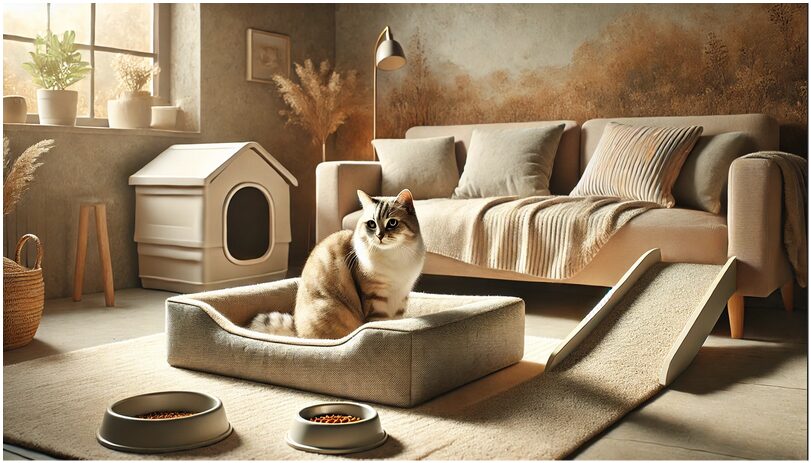As our feline companions age, they may develop health conditions that impact their quality of life. One of the most common issues in senior cats is arthritis, a condition that causes inflammation and stiffness in the joints. Arthritis can be challenging to detect in cats since they’re masters at hiding pain, but with the right care and attention, you can make your older cat’s golden years as comfortable as possible. This post will cover the signs of feline arthritis, treatment options, and practical ways to support your aging cat at home.
What Is Feline Arthritis?
Feline arthritis, also known as degenerative joint disease (DJD), occurs when the cartilage in the joints wears down, leading to pain and inflammation. Over time, the bones may rub together, causing discomfort and reducing mobility. Arthritis is most common in the hips, knees, elbows, and spine, although it can affect any joint.
While arthritis is more common in older cats, it can also develop due to injury, genetic predisposition, or obesity. Studies suggest that over 90% of cats over the age of 12 show some signs of arthritis.
Recognizing the Symptoms of Arthritis in Cats
Cats are experts at masking discomfort, so you’ll need to be observant to spot the signs of arthritis. Here are some common symptoms to watch for:
- Decreased Mobility: Your cat may avoid jumping on furniture, climbing stairs, or engaging in playful activities they once enjoyed.
- Stiffness or Limping: Especially noticeable after periods of rest, your cat may move stiffly or show an uneven gait.
- Changes in Grooming Habits: Arthritis can make it difficult for cats to reach certain areas of their body, leading to unkempt fur or mats.
- Altered Behavior: You might notice your cat becoming irritable, withdrawn, or less tolerant of handling.
- Difficulty Using the Litter Box: High-sided litter boxes can become challenging for arthritic cats to navigate.
- Weight Changes: Pain can lead to reduced activity and weight gain, or a decrease in appetite and weight loss.
Veterinary Treatments for Feline Arthritis
If you suspect your cat has arthritis, schedule a veterinary visit for a proper diagnosis and treatment plan. Here are some common veterinary interventions:
1. Prescription Medications
- Non-Steroidal Anti-Inflammatory Drugs (NSAIDs): These can reduce pain and inflammation but should only be used under veterinary supervision.
- Pain Medications: Gabapentin and other analgesics can help manage chronic pain.
- Cartilage Protectants: Supplements like glucosamine and chondroitin sulfate may slow cartilage deterioration.
2. Joint Supplements
Omega-3 fatty acids, green-lipped mussel extract, and hyaluronic acid can support joint health. Many supplements are available in cat-friendly formulations.
3. Therapeutic Injections
Injections such as polysulfated glycosaminoglycan (Adequan) can help maintain joint health and reduce inflammation.
4. Physical Therapy
Controlled exercises and veterinary-guided physical therapy can improve mobility and muscle strength.
5. Acupuncture
This holistic treatment is gaining popularity for managing arthritis pain in cats.
How to Help Your Arthritic Cat at Home
In addition to veterinary care, there are many ways to adapt your home and routine to better support your cat:
1. Create an Accessible Environment
- Use ramps or pet stairs to help your cat reach favorite resting spots.
- Provide low-sided litter boxes for easier access.
- Ensure food and water bowls are at a comfortable height.
2. Provide Supportive Bedding
Orthopedic or memory foam beds can cushion your cat’s joints and relieve pressure.
3. Encourage Gentle Exercise
Light play sessions can help maintain muscle mass and joint flexibility. Use toys that encourage slow, controlled movements rather than vigorous jumping or running.
4. Maintain a Healthy Weight
Obesity places extra strain on joints, so work with your vet to create a diet plan that keeps your cat at a healthy weight.
5. Use Heat Therapy
Heating pads or warm towels can soothe stiff joints. Ensure they are set to a safe temperature and monitor your cat to prevent burns.
6. Consider Environmental Enrichment
Adding scratchers, cozy hiding spots, and cat-safe window perches can keep your cat mentally stimulated and content.
The Importance of Routine Veterinary Checkups
Regular vet visits are essential for monitoring your cat’s arthritis and adjusting their treatment plan as needed. Your vet may recommend periodic bloodwork to ensure medications aren’t causing adverse effects, especially in senior cats.
Final Thoughts: Quality of Life Matters
Arthritis is a progressive condition, but with early intervention and the right care, you can significantly improve your cat’s quality of life. Pay attention to your cat’s behavior, make your home arthritis-friendly, and work closely with your veterinarian to manage pain and mobility challenges.
Your aging feline companion has given you years of love and loyalty—it’s only fair to ensure they spend their golden years as comfortably as possible.
Additional Resources
- American Association of Feline Practitioners (AAFP) Arthritis Guidelines
- Cornell Feline Health Center
- International Cat Care
If you have an aging cat with arthritis, let us know how you’ve helped them. Share your tips and tricks in the comments below—we’d love to hear from you!







I love how this site makes complex topics so clear. Great resource!